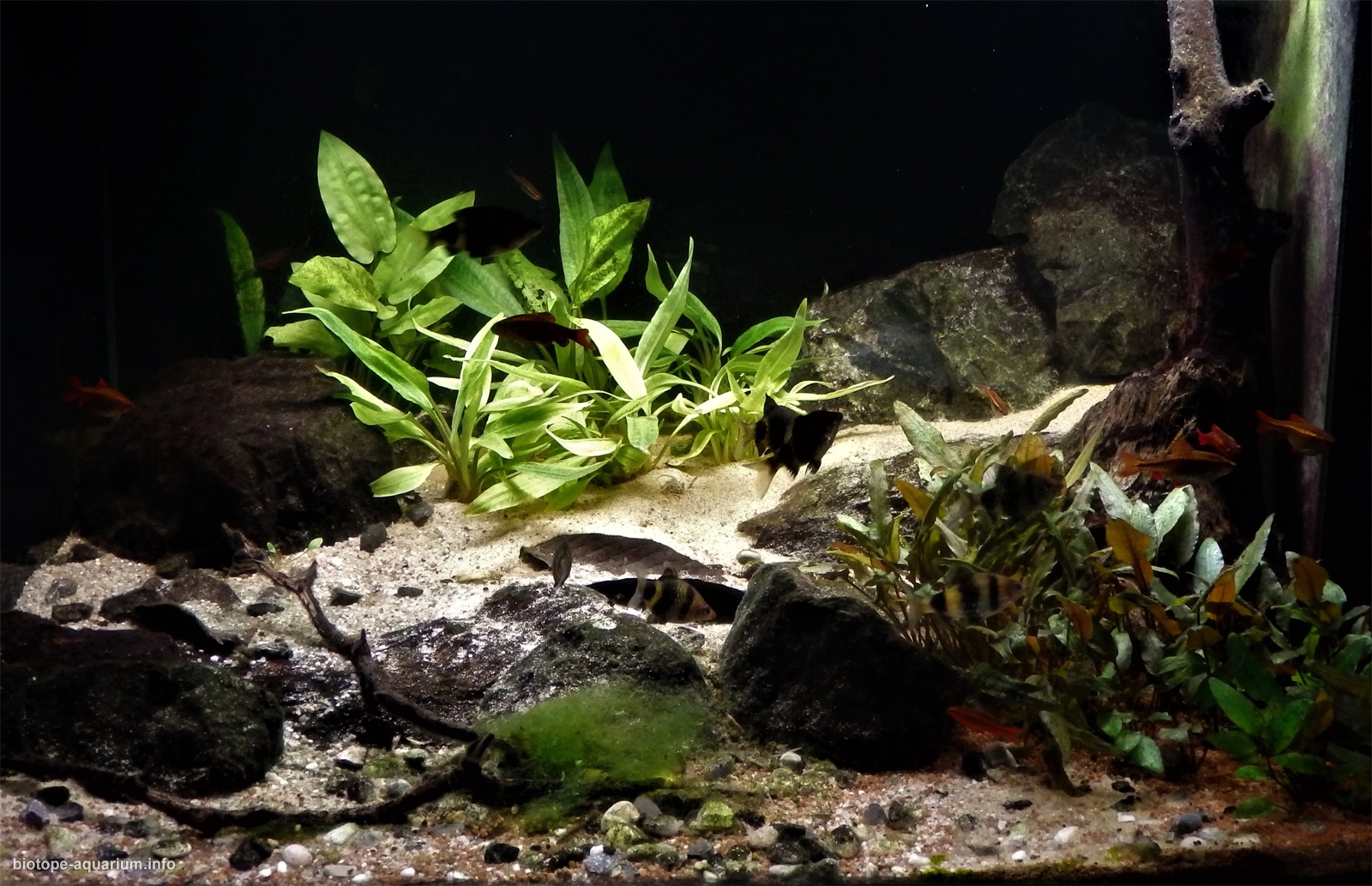Edge of small forest stream in Nilwala basin, Sri Lanka
56th place in Biotope Aquarium Design Contest 2017
![]() Belgium. Jeroen Vanhooren
Belgium. Jeroen Vanhooren

Volume: 100 L
Dimensions: 70x33x50 cm
List of fishes: Puntius titteya and Pethia nigrofasciata
List of plants: Cryptocoryne beckettii and Lagenandra thwaitesii
Description of decorations: A mix of sandtypes, but predominately fine sand, different sizes of gravel. There are some smaller greyish rocks in this biotope, as could be seen in the youtube videos cited before. Few twigs, few branches, twigs and a little bit of leaves complete this scenery.
Description of equipment: internal sump, Juwel Eccoflow 600 lph, LED lights 28W 6800 K, automatic waterchange system with dripping technology.
Water parameters: Temperature is 25°C, pH is 6.5, kH is 3.
Description of the area surrounding the biotope: Nilwala river lays in the wet zone in south western Sri Lanka. It is the largest river in Matara district. Nilwala river is 70 km long and discharges in Matara in the Indian Ocean. It originates at Panilkanda at an altitude of 1050 m from the Sinharaja rain forest. River basin is 1073 km². Up to Bopagoda the terrain is hilly with rocky riverbeds and steep slopes. Downstream longitudinal slope diminishes. The lower basin is prone to severe floodings with south west monsoon rains from May-June and with cyclonic activities October-November. Due to the fact that the island has been isolated for a long while and due to the moist, warm climate, there is a very high rate of endemism, this makes this area of Sri Lanka a place of very special interest. The typical rainforest stream biotopes are shaded due to the overhanging forest canopy, but they are exposed to some degree of sunlight. Macrophytes are uncommon in these areas but riparian vegetation can be dense. It is an ideal place for smaller fishes to hide from predators.
Description of the underwater landscape of the biotope: The middle part of the river (where this biotope lies) has alluvial soils. Alluvium is typically made up of a variety of materials. Substrate of this biotope is dominated by sand with some small rocks, twigs, branches and some larger leaf litter.
Description of the parameters of the habitat: Water is transparent, a little tea coloured. TDS values range between 42.9 to 3,488.7 mg l -1, with highest values in the downstream urban areas. Alkalinity varies between 19.9 and 177mgl-1, with the higher values linked to agricultural activities. pH range is 6,5-7. Temperature is relatively cool.
List of fishes: Puntius titteya, Channa orientalis, Rasboroides vaterifloris, Puntius bimaculatus, P. kelumi, Pethia nigrofasciata, Dawkinsia singhala, Schistura notostigma, Mystus vittatus, Aplocheilus werneri, Malpulutta kretseri, Mastacembelus armatus, Lepidocephalichthys jonklaasi,Devario pathirana, Rasbora wilpita and many others.
List of plants: Riparian vegetation mainly Cryptocoryne beckettii and Lagenandra thwaitesii. In the broader environment Aponogeton rigidifolius (which prefers deeper waters) and Hygrophila sp. occur.
Threats to the ecology: Sadly enough the Sri Lankan rainforest is under a terrible amount of threat, in 2006 only 4.6 % of the original rainforest was intact as a result of anthropogenic activities such as habitat loss for plantation establishment, river sand mining and oil extraction. A recent oil spill was also reported at the beginning of 2017 and a large-scale river diversion is also being planned, which will cause unmitigable destruction and could spell disaster for many endemic fishes. This type of highly damaging and often irreversible action inevitably has devastating and significant negative impact on these unique and vulnerable ecosystems. During the rainy season, there is less capacity of the ground to hold the water and soil, since the extensive root systems of established forests are responsible for this very job. This leads to formation of mud streams, erosion of the land leading to loss of fertile soil and siltation of the streams and rivers. In combination with disturbed self-purification processes of the rivers, this leads to lack of high quality freshwater to use as drinking water. Siltation itself leads to smothering of the riverbed and mass kill off of invertebrates and fish eggs, resulting in reduced spawning success or abandonment by fish; secondary effects are unpredictable and numerous. As if these pressures were not enough, invasive species, untreated household water, gold mining and a certain pressure from the unregulated ornamental fish industry contribute to this sad story.
Sources of information:
- http://cefishessentials.com/blog/biotope-aquarium-101-an-authentic-sri-lankan-rainforest-biotope-for-cherry-barbs/
- http://biotopeaquarium.freeforums.net/thread/23/habitat-puntius-titteya-lanka-kelanihttp://archive.riversymposium.com/index.php?element=PIYADASA
- http://www.adpc.net/igo/contents/media/media-news.asp?pid=1014&topic=#sthash.GpSpxtqr.dpbs
- http://www.icharm.pwri.go.jp/publication/pdf/pdf_0706/sri_e.pdf
- https://books.google.be/books?id=tVw_AAAAQBAJ&pg=PA211&lpg=PA211&dq=nilwala+matara&source=bl&ots=7o0rvOU6lO&sig=O99CkN19jnbC6utnbWULBo6wiJw&hl=nl&sa=X&ved=0ahUKEwjAodPSi7zWAhUNfFAKHVE7AI4Q6AEIZjAL#v=onepage&q=nilwala%20matara&f=false
- https://books.google.be/books?id=Wnp43jePLAMC&pg=PA6&lpg=PA6&dq=nilwala+river+70+km&source=bl&ots=0L6fOWfO5X&sig=OMPR4beTxSZl8oXzduc0KhMiWqI&hl=nl&sa=X&ved=0ahUKEwiDxY6CjbzWAhUHEVAKHVeKBjsQ6AEINjAF#v=onepage&q=nilwala%20river%2070%20km&f=false
- https://www.slideshare.net/dsamkhan/freshwater-biodiversity-of-sri-lanka
- http://www.cea.lk/web/images/pdf/redlist2012.pdf
- https://www.youtube.com/watch?v=9_C4aCYOruUhttps://www.youtube.com/watch?v=cxmDnpjnV2Ygbif.org
